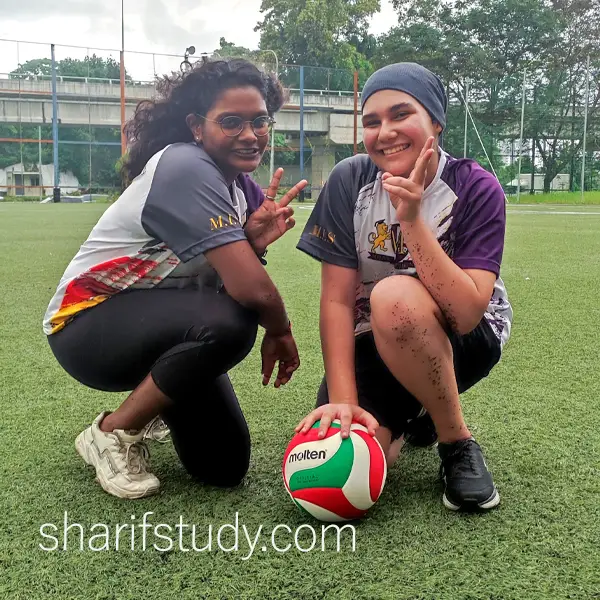When we talk about Marefat International School’s facilities, we mean the different places in the school where students learn, play, and relax. The school has many great places for students. In this guide, we will tell you about these places, like the classrooms, sports areas, and spots to unwind. If you want to learn more about what Marefat International School offers to students, this guide is a good place to start.
Extracurricular activities help showcase your skills, interests, and values that go beyond academic achievements. They give universities a clearer picture of who you are as a person and what you could bring to their community. For example, involvement in sports could indicate teamwork skills, while participation in drama clubs might suggest creativity and confidence in public speaking. Similarly, volunteering for a local charity can show a sense of social responsibility. These activities not only highlight your personal strengths but also demonstrate your ability to manage your time effectively, balancing education with other interests.
Moreover, these activities also offer opportunities for leadership. Universities appreciate students who can show they have taken initiative, motivated others, or made a significant impact in their roles within clubs, teams, or organizations. This demonstrates that you’re not just a passive participant, but someone who can lead and make decisions. These are qualities that universities value as they’re not just looking for students who will excel in their academic life but also contribute to the campus community and beyond. Whether it’s being the captain of a sports team, organizing events in a club, or taking a lead role in a community project, these leadership experiences can make your college application stand out.
Robotics

Students can use robotics in the classroom to transform their knowledge into creativity and innovation.
Integrating robotics in the classroom offers an engaging and hands-on way for students to understand complex concepts. It helps turn abstract theories into tangible learning experiences. For instance, when students build a robot, they apply mathematical concepts, physics principles, and programming skills to make it move and perform tasks. This not only strengthens their understanding of these subjects but also enhances their problem-solving skills as they troubleshoot and refine their designs. Moreover, it cultivates their creativity as they can experiment with different configurations and functionalities for their robots.
Furthermore, robotics can foster collaboration and teamwork among students. In the process of designing and building robots, students often work in groups where they share ideas, divide tasks, and collectively solve problems. This encourages them to learn from each other, communicate effectively, and work together towards a common goal. Not to mention, it prepares them for future workplaces that value cooperative problem-solving and teamwork. Thus, the incorporation of robotics in education not only facilitates academic learning but also develops important life skills.
Art
Marefat provides students with an exceptional learning environment through top-notch instruction and project-based learning.
Marefat focuses on giving students real-world experiences and skills through project-based learning. This approach involves students working on projects that require critical thinking, problem-solving, and decision-making. They might be asked to conduct research, design a product, or even run a campaign, depending on the nature of the project. By doing so, students get the opportunity to apply the concepts they learn in class to practical scenarios. This not only solidifies their understanding but also allows them to see the relevance of their studies in real-world contexts.
Furthermore, the teachers at Marefat are dedicated to providing the highest quality instruction. They are equipped with the knowledge and tools to support each student’s learning process. Teachers work closely with students, providing individual attention and guidance to ensure they understand the material thoroughly. They utilize a variety of teaching strategies to accommodate different learning styles and pace. This personal and dynamic approach to teaching fosters an environment where students feel supported and motivated to learn, contributing to their overall academic success.
Taekwondo
Their Taekwondo class was split into these three groups:
Stretching and a very light cardio exercise, such jogging or jumping jacks, are included in the warm-up. Kicking drills, Poomsae (forms) practice, and sparring sessions would all be part of the practice.
After the initial warm-up, students dive into kicking drills which form the foundation of Taekwondo. These drills focus on building strength, improving flexibility, and enhancing precision in executing various kicks. They also serve as a great tool to improve balance and coordination. Each student is encouraged to perform at their own pace, gradually increasing speed and intensity as their skills develop. Over time, they become capable of performing high, fast, and powerful kicks which are integral to Taekwondo.
Next, students practice Poomsae, or forms, which are a series of defensive and offensive movements performed against imaginary opponents. Through Poomsae practice, students can enhance their understanding of each movement, learning how to flow seamlessly from one stance to another. The practice is meditative and helps students develop focus and discipline. Lastly, the class ends with sparring sessions where students get a chance to apply their skills in a controlled environment. This gives them a sense of practical application and an opportunity to improve their reactions and strategies. Over time, students gain confidence in their abilities and build a solid foundation in Taekwondo.
Dance
Basic music theory is introduced in the Rhythmic Analysis course, which is done concurrently with Composition II and helps your study of producing dance.
Board game
Even simple games encourage young players to recognize colors, count empty spaces, and improve their dexterity and hand-eye coordination by moving the cards and other game components about the board.
Playing such simple games is a fun way for children to boost their cognitive skills. The process of recognizing different colors and associating them with various elements of the game fosters their visual perception. This also subtly introduces them to the basics of sorting and categorizing based on color. Similarly, counting empty spaces on the board reinforces their understanding of numbers and helps them develop early math skills. Over time, these games help children become more comfortable with numerical concepts and can spark an interest in math.
Beyond cognitive development, these games also offer a great platform to hone motor skills. The action of picking up cards, placing game pieces, and maneuvering them around the board requires precision and control. This can greatly improve children’s dexterity and hand-eye coordination, which are vital for many everyday activities. Plus, as they become more adept at handling game components, they gain confidence in their abilities. These games, therefore, provide a holistic learning experience, combining educational and developmental benefits with the joy of play.
Music
Language and reasoning-related brain regions are better able to develop in children who have received musical training at a young age.
Songs can aid in the imprinting of knowledge in young minds, and music promotes the left side of the brain’s better development.
Drama
Children are urged to take turns during each session and to listen to each other’s thoughts and ideas. Children can learn the value of attention through these activities, a skill that is important outside of the home.
In these interactive sessions, children learn the importance of patience and respect for others. When they wait for their turn, they practice self-control and realize that everyone has an equal right to participate. This understanding goes a long way in fostering a sense of fairness and equality. Moreover, they become aware that waiting for their turn does not diminish their fun or learning but contributes to the overall harmony of the group activity.
Listening to each other’s thoughts and ideas nurtures empathy and broadens their perspectives. They learn to appreciate diverse viewpoints and understand that every individual thinks differently. This awareness helps them become better communicators and more receptive to feedback. Furthermore, by giving attention to their peers, they learn to value others’ contributions, fostering an environment of mutual respect. In the long run, these learned behaviors are crucial in developing strong interpersonal relationships, both in their personal lives and future professional settings.
 SharifStudy Best way to Study in Malaysia
SharifStudy Best way to Study in Malaysia







